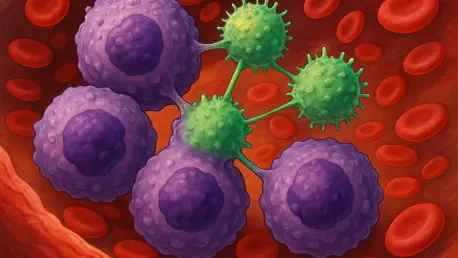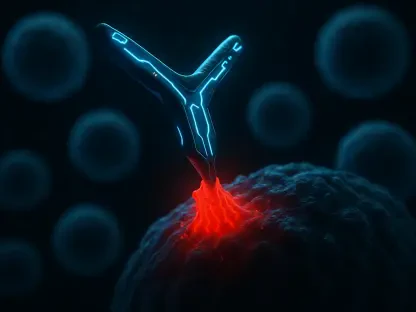In a landscape where acute myeloid leukemia (AML) claims countless lives with a disheartening five-year survival rate hovering just above 30 percent, a recent discovery offers a glimmer of hope for those battling this aggressive blood cancer. Researchers at Lund University have uncovered a pivotal mechanism that could transform the approach to treating AML, a disease notorious for its resistance to conventional therapies like chemotherapy and stem cell transplantation. This groundbreaking finding centers on a specific surface protein that enables cancer cells to slip past the immune system’s defenses, allowing the disease to progress unchecked. The implications of this research signal a potential shift toward more targeted and less toxic treatments, addressing a critical gap in current medical options for AML patients. As the scientific community rallies around this development, it becomes clear that this could mark the beginning of a new era in immunotherapy for a malignancy that has long evaded effective solutions.
Unveiling a Hidden Mechanism in AML
Discovering the Role of SLAMF6
A significant stride in understanding AML has emerged from the meticulous efforts of researchers who sought to identify unique markers on leukemia stem cells that distinguish them from healthy blood stem cells. Through comprehensive protein mapping of bone marrow samples from AML patients, the team pinpointed SLAMF6, a surface protein exclusively expressed on cancerous cells. This discovery, validated across a cohort of 50 patients, underscores the protein’s specificity to AML, making it a promising target for therapies designed to spare healthy tissues. The precision of this finding is crucial, as it minimizes the risk of collateral damage often associated with broader treatments. By focusing on a marker unique to the disease, the research lays a foundation for interventions that could be both more effective and less harmful, potentially redefining how AML is approached in clinical settings.
Immune Evasion Tactics of AML Cells
Delving deeper into the function of SLAMF6, the research revealed its sinister role in shielding AML cells from the immune system, particularly from T cells tasked with eliminating threats. Utilizing advanced CRISPR/Cas9 gene editing techniques, the team demonstrated that this protein actively suppresses immune detection, allowing cancer to proliferate without interference. This mechanism explains why AML often resists immunotherapy, a treatment that has shown remarkable success in other cancers but struggles against this particular malignancy. Understanding how SLAMF6 operates provides critical insight into the disease’s persistence and opens up new avenues for disrupting its defenses. The ability of cancer cells to hide in plain sight through such molecular trickery highlights the complexity of AML and the urgent need for innovative strategies to counteract these evasion tactics in future therapeutic designs.
Paving the Way for Targeted Therapies
Developing a Game-Changing Antibody
In a remarkable advancement, collaboration with the SciLifeLab Drug Discovery and Development Platform led to the creation of an antibody capable of blocking SLAMF6. This intervention proved transformative in laboratory experiments and mouse models, where it enabled T cells to recognize and attack leukemia cells with renewed vigor. The success of this antibody addresses a longstanding barrier in AML immunotherapy, offering a potential reason for its limited effectiveness in the past and suggesting a path forward for more tailored solutions. This development is a testament to the power of precision medicine, where treatments are designed to target specific disease mechanisms rather than relying on broad, often toxic approaches. While the results are promising, researchers caution that translating these findings into clinical practice will require extensive further study to ensure both safety and efficacy for patients.
The Future of Personalized Cancer Treatment
The identification of SLAMF6 as a therapeutic target aligns with the broader trend in oncology toward personalized cancer therapy, where treatments are customized to the unique profile of a patient’s tumor. This approach reflects a growing consensus that disrupting cancer’s ability to evade immune detection is essential for improving outcomes in challenging diseases like AML. The hope is to move away from harsh, generalized treatments toward options that are both gentler and more effective, tailored to individual needs. However, the journey from lab to clinic remains fraught with challenges, necessitating rigorous testing and clinical trials over the coming years to validate these findings. This research not only deepens the understanding of AML’s complex defenses but also fuels optimism for a future where patients might access therapies that significantly enhance their quality of life and survival chances.
Reflecting on a Milestone Achievement
Building on a Foundation of Discovery
Looking back, the efforts of the Lund University team to uncover the role of SLAMF6 in AML represented a pivotal moment in cancer research. Their detailed mapping of proteins and subsequent validation across multiple patient samples established a robust case for targeting this specific marker. The revelation that SLAMF6 played a key role in immune suppression was a critical insight, shedding light on why previous immunotherapies faltered against this disease. This foundational work, blending cutting-edge technology with a deep commitment to understanding AML, set a new benchmark for how specific proteins could be leveraged to combat cancer. It was a step that underscored the importance of precision in medical research, ensuring that each discovery built toward a more nuanced understanding of a devastating illness.
Charting the Next Steps in AML Research
As the scientific community reflected on this achievement, the focus shifted to actionable next steps that could bridge the gap between laboratory success and real-world application. The development of the SLAMF6-blocking antibody was a promising start, but it was clear that extensive clinical trials were needed to refine its use and confirm its benefits for patients. Beyond this, there was a call for broader exploration into other potential targets within AML, ensuring a multifaceted approach to treatment. The emphasis remained on fostering collaboration across research institutions and platforms to accelerate progress. Additionally, integrating these findings with emerging technologies in personalized medicine was seen as vital to crafting therapies that could adapt to the unique challenges of each patient’s condition. This milestone, while significant, was viewed as a stepping stone toward a comprehensive strategy to conquer AML.









